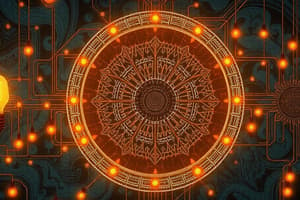Podcast
Questions and Answers
Which type of circuit is described as a circuit in which current flows continually in a complete loop?
Which type of circuit is described as a circuit in which current flows continually in a complete loop?
- Closed Circuit (correct)
- Interrupted Circuit
- Conductive Circuit
- Open Circuit
Which of the following is NOT considered a component of an electric circuit?
Which of the following is NOT considered a component of an electric circuit?
- Capacitors
- Magnets (correct)
- Insulators
- Resistors
What type of material is used as an insulator in circuits?
What type of material is used as an insulator in circuits?
- Copper
- Plastic (correct)
- Silver
- Aluminum
In an open circuit, what disrupts the path for current flow?
In an open circuit, what disrupts the path for current flow?
What is the relationship between voltage, current, and resistance according to Ohm's Law?
What is the relationship between voltage, current, and resistance according to Ohm's Law?
Which component of a circuit is responsible for controlling or altering the flow of electricity?
Which component of a circuit is responsible for controlling or altering the flow of electricity?
What is the formula for power in Joule's Law?
What is the formula for power in Joule's Law?
What does Kirchhoff's Voltage Law (KVL) state?
What does Kirchhoff's Voltage Law (KVL) state?
What happens to the total current flowing through a series circuit?
What happens to the total current flowing through a series circuit?
In a parallel circuit, how are the components connected?
In a parallel circuit, how are the components connected?
Flashcards are hidden until you start studying
Study Notes
Electricity: Exploring Circuits
Electricity is an integral part of our daily lives, powering everything from our homes to the devices we carry. To understand how electricity works, it's essential to delve into the world of circuits. Let's explore the fundamental concepts and principles of circuits, which will lay the groundwork for comprehending how electricity flows and how we harness this energy.
Components of an Electric Circuit
An electric circuit is a closed loop of conductive material through which electric current flows. Circuits consist of three basic components that make up their building blocks:
- Conductors: Materials that electricity can flow through, like copper wires.
- Insulators: Materials that do not allow electricity to flow through them, such as rubber and plastic.
- Electric Components: Devices that control or alter the flow of electricity, such as batteries, switches, resistors, capacitors, and inductors.
Circuit Types
Circuits can be classified in various ways, but the two most fundamental types are:
- Closed Circuit: A circuit in which current flows continually in a complete loop.
- Open Circuit: A circuit in which the path for current flow is disrupted, either by a broken wire or a switch that is in the "off" position.
Laws and Principles of Electricity
To understand how electricity behaves in circuits, we must study several fundamental laws and principles:
-
Ohm's Law: The relationship between voltage, current, and resistance in a circuit. Voltage (V) multiplied by resistance (R) equals current (I).
-
Joule's Law: The relationship between power, voltage, and resistance in a circuit. Power (P) equals voltage (V) multiplied by current (I) multiplied by resistance (R).
-
Kirchhoff's Laws: Two laws that govern the behavior of current and voltage in circuits: a. Kirchhoff's Current Law (KCL): The sum of currents entering a node equals the sum of currents leaving a node. b. Kirchhoff's Voltage Law (KVL): The sum of voltage changes in a closed loop equals zero.
Series and Parallel Circuits
Circuits are often arranged in series or parallel configurations. These arrangements affect the behavior of the circuit:
-
Series Circuits: In a series circuit, each component is connected directly to the next component, and the current flows through each component in succession. The voltage across each component is equal to the total circuit voltage, and the total current flowing through the circuit is the same as the current flowing through each component.
-
Parallel Circuits: In a parallel circuit, two or more components share the same voltage source, but the components are connected in parallel branches. Each branch of a parallel circuit has its own path for current to flow, and the current flowing through each branch can be different. The total voltage across each branch of a parallel circuit is equal to the total circuit voltage.
Conclusion
Understanding circuits is the first step towards comprehending electricity. Circuits consist of conductors, insulators, and electric components that control or alter the flow of electricity. The fundamental laws and principles of electricity, such as Ohm's Law and Joule's Law, govern how electricity behaves in circuits. Series and parallel circuits represent two common configurations that affect the behavior of electricity. By exploring these fundamental concepts, you'll be better equipped to make sense of the complex systems we use in our daily lives.
Studying That Suits You
Use AI to generate personalized quizzes and flashcards to suit your learning preferences.




